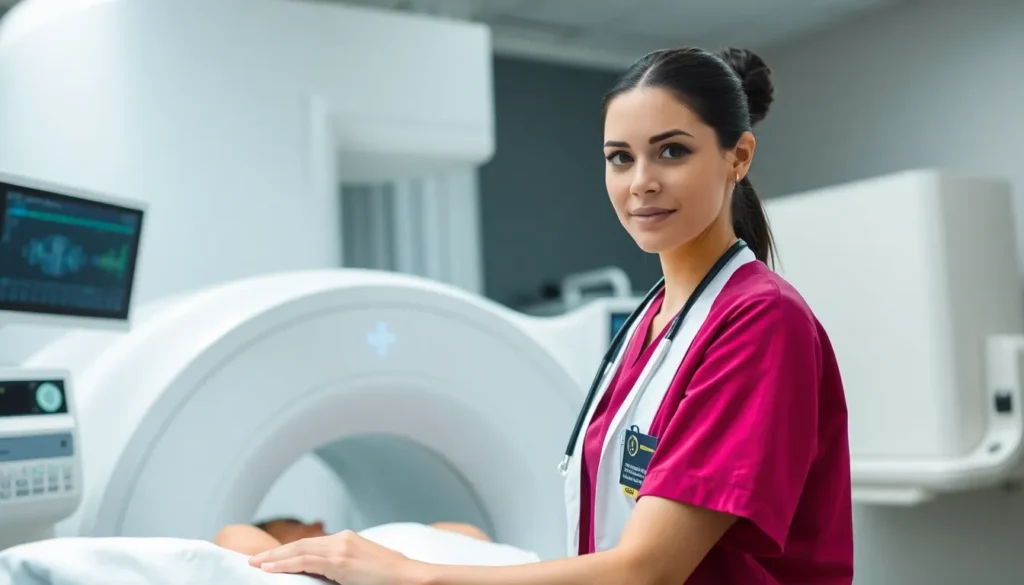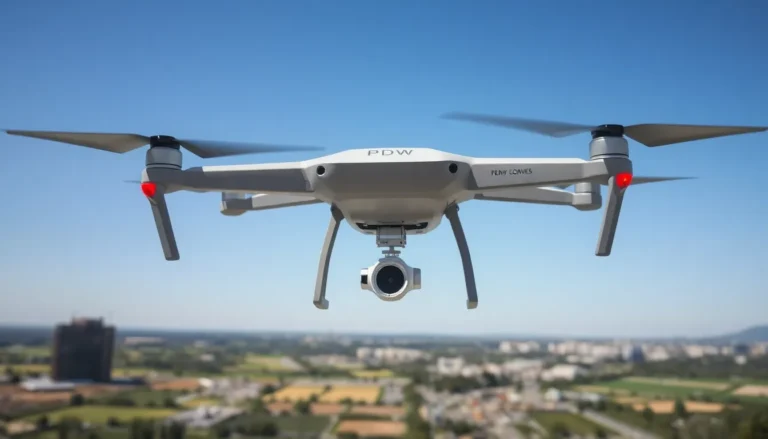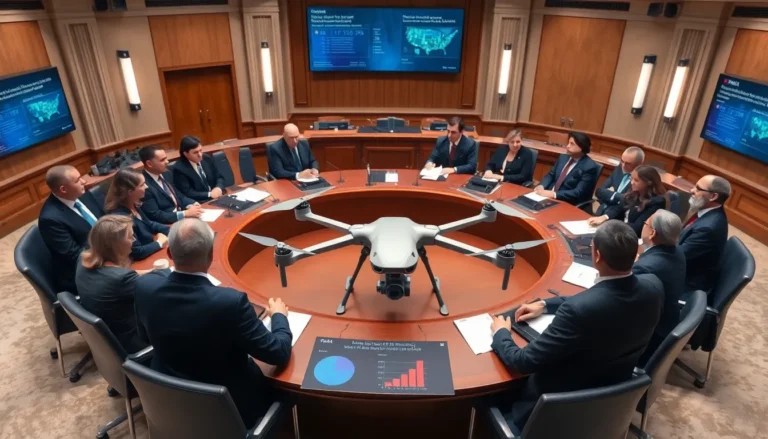Ever wondered how long it takes to become an MRI tech? Well, buckle up because this journey is more thrilling than a roller coaster ride—minus the screaming, of course. With the healthcare field booming faster than a microwave popcorn bag, MRI technicians are in high demand. They play a crucial role in diagnosing medical conditions, and the best part? It doesn’t take a lifetime to join their ranks.
Typically, aspiring MRI techs can expect to invest anywhere from one to four years in education and training. Whether it’s a quick certificate program or a more in-depth degree, there’s a path for everyone. So if you’ve got a knack for technology and a desire to help others, let’s dive into the nitty-gritty of what it takes to turn that dream into reality.
Table of Contents
ToggleOverview of MRI Technology
MRI technology plays a crucial role in modern diagnostics. Medical imaging relies heavily on MRI machines to produce detailed images of internal body structures. Radiologists utilize these images to accurately diagnose conditions, guide treatment decisions, and monitor patient progress.
The technology operates using strong magnetic fields and radio waves, allowing for high-quality imaging without radiation exposure. MRI scans can assess various tissues, including soft tissues, organs, and even blood vessels. These capabilities make MRI an essential tool in oncology, neurology, and musculoskeletal imaging.
Training in MRI technology involves understanding the physics of MRI, patient care, and safety protocols. Certification programs often cover anatomy, MRI theory, and hands-on experience with MRI equipment. Technologists must be skilled at preparing patients for scans, ensuring comfort and addressing any concerns.
Work environments for MRI techs commonly include hospitals, outpatient imaging centers, and clinics. Daily responsibilities involve operating MRI machines, maintaining equipment, and working with radiologists to review images. As the demand for non-invasive diagnostic methods continues to grow, MRI technology careers are becoming increasingly important.
Educational paths vary for aspiring MRI techs. They may choose from certificate programs, associate degrees, or bachelor’s degrees. Job options expand with higher education levels, enhancing career prospects and responsibilities. Progressing in this field often leads to roles in advanced imaging techniques or managerial positions within healthcare facilities.
Overall, MRI technology combines cutting-edge science with patient care. Advancements continue to shape the field, making it crucial for those interested in healthcare technology to consider this rewarding career path.
Education Requirements

Aspiring MRI technicians must fulfill specific education requirements. These pathways can significantly influence the time it takes to enter the field.
High School Diploma or Equivalent
A high school diploma or equivalent lays the foundational knowledge for further education. It equips students with essential skills in science and mathematics. Most programs require this credential for admission. During high school, students should focus on courses that enhance their understanding of biology and physics. This understanding proves critical when studying MRI technology later.
Associate Degree Programs
Associate degree programs in MRI technology typically span two years. These programs often cover coursework in MRI physics, patient care, and anatomy. Hands-on clinical training is also an integral component, allowing students to operate MRI machines under supervision. Graduates are eligible to sit for certification exams that enhance job prospects. Community colleges and technical schools frequently offer these degrees, making them accessible options for many.
Bachelor’s Degree Programs
Bachelor’s degree programs provide a more comprehensive education, usually taking four years to complete. These programs delve deeper into medical imaging techniques and advanced MRI practices. In addition to core subjects, students explore areas like leadership, quality management, and imaging research. Graduates often enjoy expanded career opportunities and higher earning potential. Some healthcare facilities prefer candidates with a bachelor’s degree for more advanced roles.
Certification and Training
Certification and training are crucial for becoming an MRI technician. Individuals typically need to complete an accredited program to pursue certification.
Clinical Experience
Clinical experience provides practical exposure essential for MRI technicians. Most educational programs include hands-on training in a clinical setting. Students perform tasks under supervision, ensuring that they learn about machine operation and patient interaction. Gaining this experience enhances confidence and competence in real-world scenarios. Programs often require anywhere from 16 weeks to a year of clinical training. Acquiring this invaluable experience prepares aspiring technicians for the certification exam and makes them appealing to employers.
Continuing Education
Continuing education is vital for MRI technicians to maintain certification and keep skills current. Technological advancements in MRI equipment and techniques necessitate ongoing learning. Many certifying bodies require technicians to earn continuing education credits regularly. Enrollment in workshops, seminars, and advanced courses can fulfill these requirements. Professionals can also pursue specialization in fields like pediatric imaging or functional MRI. Maintaining certifications and expanding expertise directly influences career advancement and job opportunities.
Time Commitment
Becoming an MRI technician involves a significant time commitment. Aspiring professionals should understand the various educational paths available and the time required for completion.
Total Duration of Programs
Certificate programs typically take around 1 year to finish. Associate degrees usually span 2 years, allowing for comprehensive coursework and clinical training. Bachelor’s degrees extend the commitment, generally requiring 4 years of study. Completing the required clinical hours is essential for most programs, ensuring graduates possess hands-on experience before entering the workforce.
Factors Influencing Timeframe
Several factors influence the timeframe for becoming an MRI tech. The choice between a certificate, associate, or bachelor’s degree significantly impacts duration. Candidates with prior healthcare experience may expedite their education, enabling quicker program completion. Availability of part-time versus full-time studies also plays a role. Additionally, each program’s clinical requirements can vary, affecting the overall time commitment.
Factors like location and funding may also contribute to how quickly one can finish their training. Pursuing advanced certifications can extend educational time but offer specialized skills beneficial in advancing careers.
Career Outlook
The demand for MRI technicians continues to grow in the healthcare field. According to the U.S. Bureau of Labor Statistics, employment for MRI technologists is projected to increase by 7% from 2021 to 2031, which reflects a strong job outlook. Hospitals and outpatient imaging centers frequently seek skilled professionals to meet rising patient needs. Many factors drive this expansion, including an aging population that often requires diagnostic imaging.
Advancements in MRI technology also contribute to the positive career outlook. Newly developed imaging techniques enhance diagnostic capabilities and create opportunities for specialized roles. These innovations often require trained MRI techs to adapt and learn new protocols. Such continuing education remains vital for professionals in maintaining certifications.
Flexibility in educational pathways offers additional opportunities for career growth. Many MRI technicians find that obtaining an associate degree positions them well for entry-level roles. Others pursue bachelor’s degrees to access supervisory or management positions. Candidates with advanced certifications often stand out in the job market, showcasing their expertise in specialized areas.
Job prospects remain promising, but location can influence opportunities. Urban areas typically present more openings due to higher healthcare facility concentrations. Geographic mobility can enhance employment prospects for those open to relocation. Networking within professional organizations can also provide valuable connections and job leads.
Overall, the evolving landscape of MRI technology, combined with a consistent demand for skilled professionals, creates a bright future for those pursuing a career as an MRI technician.
Becoming an MRI technician is a rewarding journey that offers numerous opportunities in the healthcare sector. With varying educational paths available it’s possible to enter the field in as little as one year or take up to four years for a more comprehensive education. The demand for skilled MRI techs continues to rise, ensuring a stable career with room for growth.
As technology evolves so do the roles and responsibilities of MRI technicians. Continuous education and specialization can enhance job prospects and career advancement. For those passionate about technology and patient care this career path presents a fulfilling future in a vital area of healthcare.








